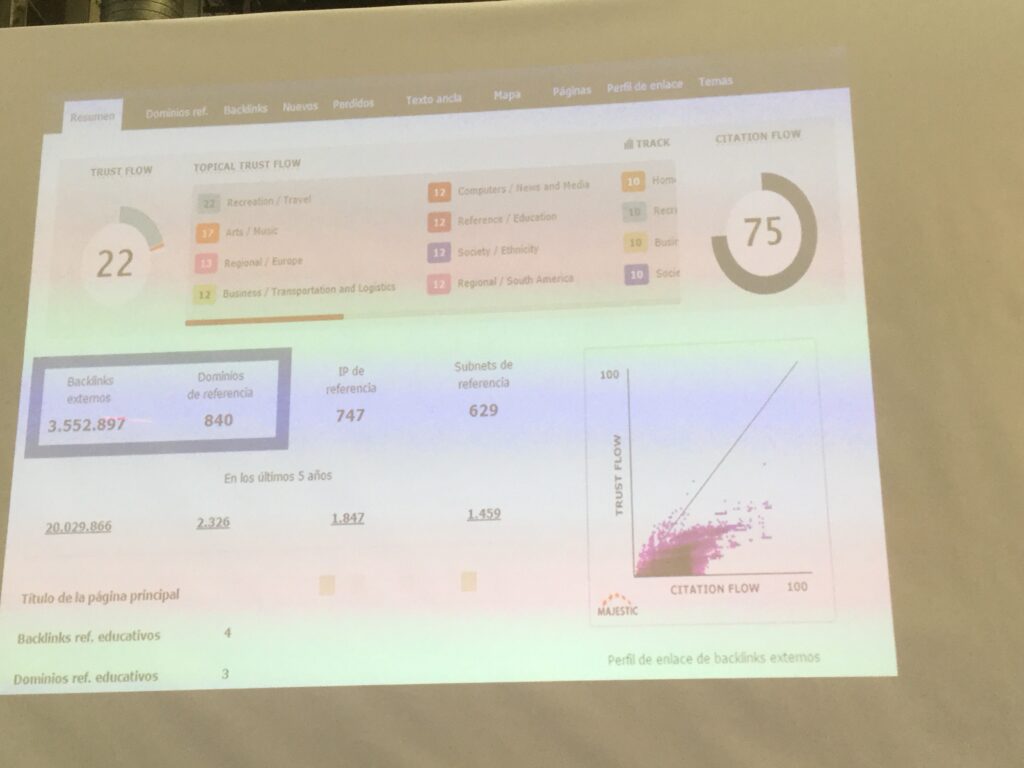Written by Fernando Maciá
Determining the quality of the link profile of our website and those of our competitors is fundamental to estimate our competitive capacity within a niche. Is a link good? What anchor text ratio is right for me? Where does the competition have an advantage over me? These and some other recurring questions will find their answer if they are unique. And the world is a controversy. César Aparicio, General Manager of Craneoprevilegiado.com.
It’s not the tool, it’s how you use it. Let’s see MajesticSEO.
Majestic SEO: introduction
When we are going to do a link-building campaign, sometimes we find domains that do not have many links. But we must start working from the root domain.
We move on to the important part of TrustFlow and CitationFlow. Maybe, for the lower values, we think that the site is not worth it. César analyzes clinicseo.es: 12,000 links from 203 referral domains. Ideally, these two numbers should match: domains and IP. Otherwise, it smells like a network of links.
Majestic gives us the backlink history of links and domains in a timeline. This is quite important to detect campaigns, when we receive and increase the number of links, when we buy massive links, etc.
A Web site has a natural tendency to link growth. Sharp rises can signal attacks, the result of link buying, link-building campaigns, etc. But we have to look at the reason.
We also see the distribution of follow and nofollow links. We believe that it is not as relevant as it is believed, at least at home. We should not be concerned. We can also see the graph in data, but the fundamental one is the distribution of anchor text that our Web site is receiving.
We can see if there is a lot of concentration on a few commercial anchor texts instead of branding in a very short time. If we are in this niche and other sites receive more brand anchor, Google may judge that we should also receive more brand anchor.
It shows data from an e-commerce that ranks very well. We see a huge number of links from a not so large number of different domains. We see that the CitationFlow is much higher than the TrustFlow. A page is best when the dots are even with respect to the middle line, not with deviations. But it can be a threat for the future.
In the evolution we can see how popularity increases at certain times: it is due to negative SEO actions.
And the distribution of anchor text: we see Chinese anchors that are putting Wimdu.es as negative SEO. But, contrary to assumptions, it positions very well.
So the criteria to judge if the profiles are good or bad are others, not so much the anchor text.
We can see links by domains, and specific URLs that are sending us links in order to analyze them. It shows Citation and Trust Flow for each URL. We can also see a tag cloud proportional to the anchors that predominate in our Web site.
You could analyze where your competitor’s linkbuilding is going by simply looking at the anchors presented in this chart. We identify that they are linking to us with the same anchor text with a very high number of links but a received number of domains. We have to analyze this. If we detect that a domain positions well in this way, we could surely surpass them if we match or improve the competition’s numbers: more links or from more different domains, or better domains (more authority).
We can deploy to analyze the sites that link to a certain anchor text so I can see the type of domains that are linking: in this case, links appear in footers or sidebars. They may or may not be bad, depending on the profile, anchor, destination, etc.
Toxic link profiles usually come geographically from Eastern and Asian countries. So it is worth looking at the source map of the links.
We can also analyze the links that reach a specific page. To do this we go to the pages section, instead of analyzing the root domain.
TrustFlow and CitationFlow graphs: their meaning is ambiguous but it is better to have all the dots concentrated on the regression line. The more dispersion, in principle, the lower the quality of domains.
What should we look at?
We can download data from Majestic, Alexa, Moz to try to establish correlations between TrustFlow, Domain Authority, Alexa, etc. And we can make our correlation graphs. In general, if DA increases, TrustFlow increases. However, there is no correlation with Alexa: it is not used to measure link quality.
When the CitationFlow is very high and the TrustFlow is very low, it can mean that we can have problems.
But keep in mind that we are trying to compete with machines.




